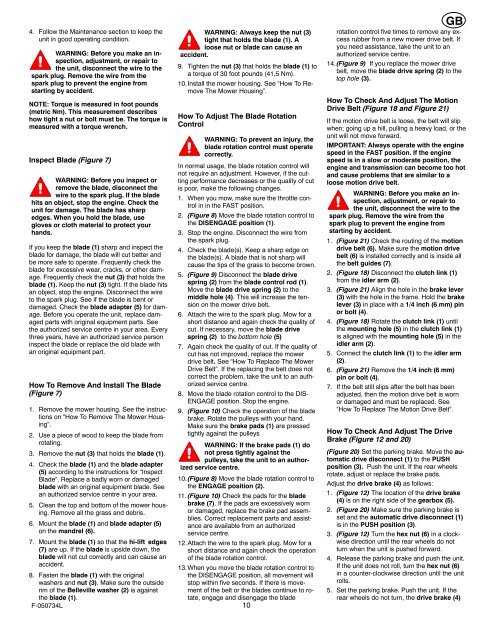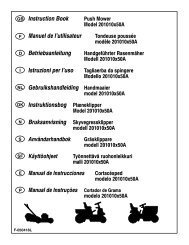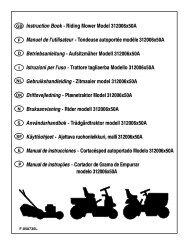Instruction Book − Riding Mower Model ... - Safe Motor AS
Instruction Book − Riding Mower Model ... - Safe Motor AS
Instruction Book − Riding Mower Model ... - Safe Motor AS
You also want an ePaper? Increase the reach of your titles
YUMPU automatically turns print PDFs into web optimized ePapers that Google loves.
4. Follow the Maintenance section to keep the<br />
unit in good operating condition.<br />
WARNING: Before you make an inspection,<br />
adjustment, or repair to<br />
the unit, disconnect the wire to the<br />
spark plug. Remove the wire from the<br />
spark plug to prevent the engine from<br />
starting by accident.<br />
NOTE: Torque is measured in foot pounds<br />
(metric Nm). This measurement describes<br />
how tight a nut or bolt must be. The torque is<br />
measured with a torque wrench.<br />
Inspect Blade (Figure 7)<br />
WARNING: Before you inspect or<br />
remove the blade, disconnect the<br />
wire to the spark plug. If the blade<br />
hits an object, stop the engine. Check the<br />
unit for damage. The blade has sharp<br />
edges. When you hold the blade, use<br />
gloves or cloth material to protect your<br />
hands.<br />
If you keep the blade (1) sharp and inspect the<br />
blade for damage, the blade will cut better and<br />
be more safe to operate. Frequently check the<br />
blade for excessive wear, cracks, or other damage.<br />
Frequently check the nut (3) that holds the<br />
blade (1). Keep the nut (3) tight. If the blade hits<br />
an object, stop the engine. Disconnect the wire<br />
to the spark plug. See if the blade is bent or<br />
damaged. Check the blade adapter (5) for damage.<br />
Before you operate the unit, replace damaged<br />
parts with original equipment parts. See<br />
the authorized service centre in your area. Every<br />
three years, have an authorized service person<br />
inspect the blade or replace the old blade with<br />
an original equipment part.<br />
How To Remove And Install The Blade<br />
(Figure 7)<br />
1. Remove the mower housing. See the instructions<br />
on “How To Remove The <strong>Mower</strong> Housing”.<br />
2. Use a piece of wood to keep the blade from<br />
rotating.<br />
3. Remove the nut (3) that holds the blade (1).<br />
4. Check the blade (1) and the blade adapter<br />
(5) according to the instructions for “Inspect<br />
Blade”. Replace a badly worn or damaged<br />
blade with an original equipment blade. See<br />
an authorized service centre in your area.<br />
5. Clean the top and bottom of the mower housing.<br />
Remove all the grass and debris.<br />
6. Mount the blade (1) and blade adapter (5)<br />
on the mandrel (6).<br />
7. Mount the blade (1) so that the hi-lift edges<br />
(7) are up. If the blade is upside down, the<br />
blade will not cut correctly and can cause an<br />
accident.<br />
8. Fasten the blade (1) with the original<br />
washers and nut (3). Make sure the outside<br />
rim of the Belleville washer (2) is against<br />
the blade (1).<br />
F-050734L<br />
WARNING: Always keep the nut (3)<br />
tight that holds the blade (1). A<br />
loose nut or blade can cause an<br />
accident.<br />
9. Tighten the nut (3) that holds the blade (1) to<br />
a torque of 30 foot pounds (41,5 Nm).<br />
10.Install the mower housing. See “How To Remove<br />
The <strong>Mower</strong> Housing”.<br />
How To Adjust The Blade Rotation<br />
Control<br />
WARNING: To prevent an injury, the<br />
blade rotation control must operate<br />
correctly.<br />
In normal usage, the blade rotation control will<br />
not require an adjustment. However, if the cutting<br />
performance decreases or the quality of cut<br />
is poor, make the following changes.<br />
1. When you mow, make sure the throttle control<br />
in in the F<strong>AS</strong>T position.<br />
2. (Figure 8) Move the blade rotation control to<br />
the DISENGAGE position (1).<br />
3. Stop the engine. Disconnect the wire from<br />
the spark plug.<br />
4. Check the blade(s). Keep a sharp edge on<br />
the blade(s). A blade that is not sharp will<br />
cause the tips of the grass to become brown.<br />
5. (Figure 9) Disconnect the blade drive<br />
spring (2) from the blade control rod (1).<br />
Move the blade drive spring (2) to the<br />
middle hole (4). This will increase the tension<br />
on the mower drive belt.<br />
6. Attach the wire to the spark plug. Mow for a<br />
short distance and again check the quality of<br />
cut. If necessary, move the blade drive<br />
spring (2) to the bottom hole (5)<br />
7. Again check the quality of cut. If the quality of<br />
cut has not improved, replace the mower<br />
drive belt. See “How To Replace The <strong>Mower</strong><br />
Drive Belt”. If the replacing the belt does not<br />
correct the problem, take the unit to an authorized<br />
service centre.<br />
8. Move the blade rotation control to the DIS-<br />
ENGAGE position. Stop the engine.<br />
9. (Figure 10) Check the operation of the blade<br />
brake. Rotate the pulleys with your hand.<br />
Make sure the brake pads (1) are pressed<br />
tightly against the pulleys<br />
WARNING: If the brake pads (1) do<br />
not press tightly against the<br />
pulleys, take the unit to an authorized<br />
service centre.<br />
10.(Figure 8) Move the blade rotation control to<br />
the ENGAGE position (2).<br />
11. (Figure 10) Check the pads for the blade<br />
brake (7). If the pads are excessively worn<br />
or damaged, replace the brake pad assemblies.<br />
Correct replacement parts and assistance<br />
are available from an authorized<br />
service centre.<br />
12.Attach the wire to the spark plug. Mow for a<br />
short distance and again check the operation<br />
of the blade rotation control.<br />
13.When you move the blade rotation control to<br />
the DISENGAGE position, all movement will<br />
stop within five seconds. If there is movement<br />
of the belt or the blades continue to rotate,<br />
engage and disengage the blade<br />
10<br />
GB<br />
rotation control five times to remove any excess<br />
rubber from a new mower drive belt. If<br />
you need assistance, take the unit to an<br />
authorized service centre.<br />
14.(Figure 9) If you replace the mower drive<br />
belt, move the blade drive spring (2) to the<br />
top hole (3).<br />
How To Check And Adjust The Motion<br />
Drive Belt (Figure 18 and Figure 21)<br />
If the motion drive belt is loose, the belt will slip<br />
when; going up a hill, pulling a heavy load, or the<br />
unit will not move forward.<br />
IMPORTANT: Always operate with the engine<br />
speed in the F<strong>AS</strong>T position. If the engine<br />
speed is in a slow or moderate position, the<br />
engine and transmission can become too hot<br />
and cause problems that are similar to a<br />
loose motion drive belt.<br />
WARNING: Before you make an inspection,<br />
adjustment, or repair to<br />
the unit, disconnect the wire to the<br />
spark plug. Remove the wire from the<br />
spark plug to prevent the engine from<br />
starting by accident.<br />
1. (Figure 21) Check the routing of the motion<br />
drive belt (6). Make sure the motion drive<br />
belt (6) is installed correctly and is inside all<br />
the belt guides (7).<br />
2. (Figure 18) Disconnect the clutch link (1)<br />
from the idler arm (2).<br />
3. (Figure 21) Align the hole in the brake lever<br />
(3) with the hole in the frame. Hold the brake<br />
lever (3) in place with a 1/4 inch (6 mm) pin<br />
or bolt (4).<br />
4. (Figure 18) Rotate the clutch link (1) until<br />
the mounting hole (5) in the clutch link (1)<br />
is aligned with the mounting hole (5) in the<br />
idler arm (2).<br />
5. Connect the clutch link (1) to the idler arm<br />
(2).<br />
6. (Figure 21) Remove the 1/4 inch (6 mm)<br />
pin or bolt (4).<br />
7. If the belt still slips after the belt has been<br />
adjusted, then the motion drive belt is worn<br />
or damaged and must be replaced. See<br />
“How To Replace The Motion Drive Belt”.<br />
How To Check And Adjust The Drive<br />
Brake (Figure 12 and 20)<br />
(Figure 20) Set the parking brake. Move the automatic<br />
drive disconnect (1) to the PUSH<br />
position (3). Push the unit. If the rear wheels<br />
rotate, adjust or replace the brake pads.<br />
Adjust the drive brake (4) as follows:<br />
1. (Figure 12) The location of the drive brake<br />
(4) is on the right side of the gearbox (5).<br />
2. (Figure 20) Make sure the parking brake is<br />
set and the automatic drive disconnect (1)<br />
is in the PUSH position (3).<br />
3. (Figure 12) Turn the hex nut (6) in a clockwise<br />
direction until the rear wheels do not<br />
turn when the unit is pushed forward.<br />
4. Release the parking brake and push the unit.<br />
If the unit does not roll, turn the hex nut (6)<br />
in a counter-clockwise direction until the unit<br />
rolls.<br />
5. Set the parking brake. Push the unit. If the<br />
rear wheels do not turn, the drive brake (4)





